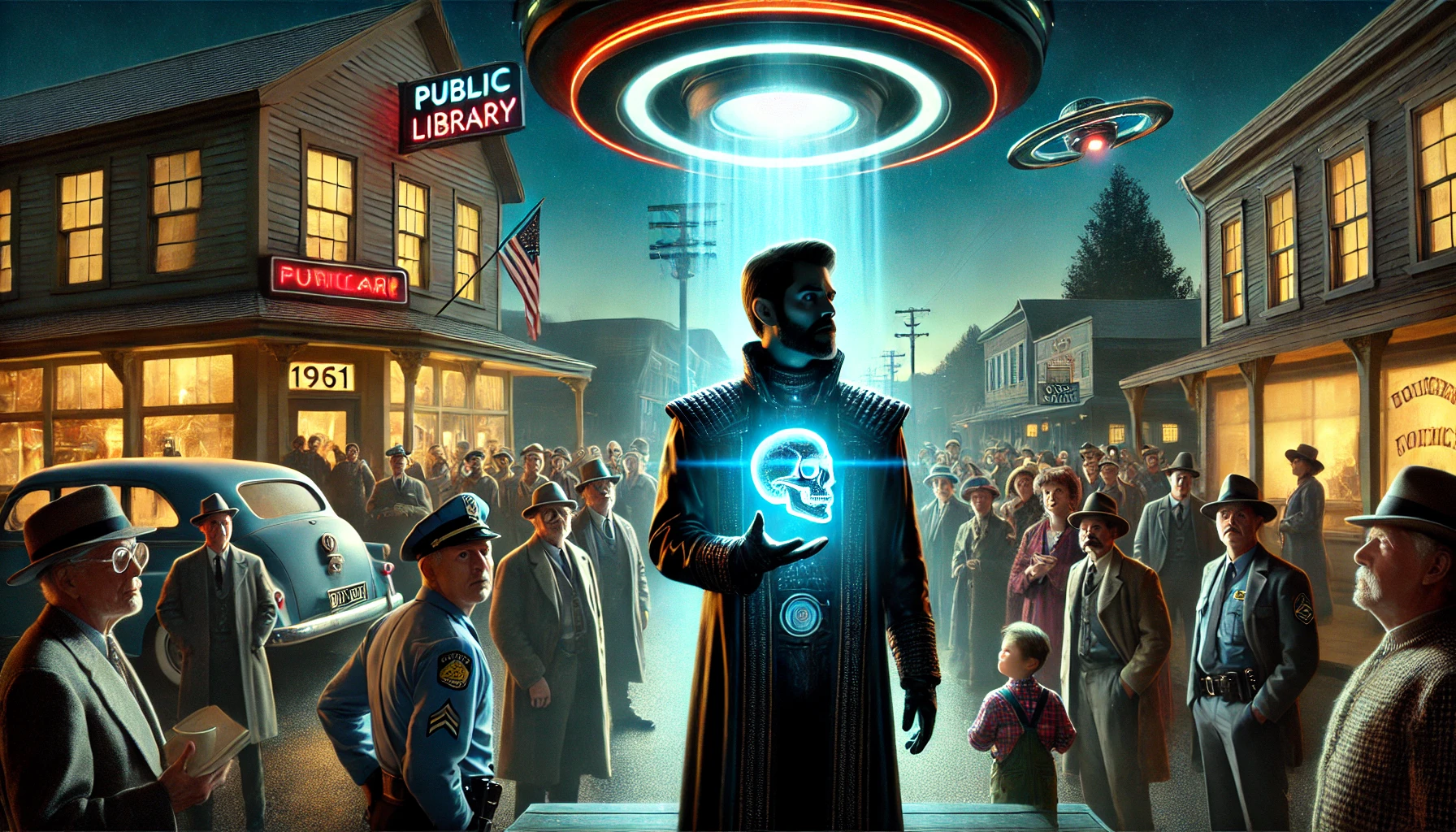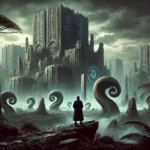The Skull is a science fiction short story by Philip K. Dick, first published in 1952. Known for his explorations of reality, identity, and human consciousness, Dick offers a time-travel tale centered on themes of predestination, paradox, and the influence of ideology. In this story, a man named Conger is given the task of going back in time to kill a mysterious figure known as the Founder, only to confront shocking revelations about his own fate.
Plot Summary
A thin man sat in a cold, dim room, wearing the drab gray of a prisoner. The Speaker stood before him, well-dressed and calm, explaining a unique opportunity. For Conger, a criminal, the mission was simple yet chilling: he was to go back in time and kill a man known only as the Founder. There were no other details beyond this—just the urgency of the mission. The Founder had started a dangerous movement, a pacifist philosophy that grew into a powerful Church, which now obstructed the rule of the authoritarian government of Conger’s time. The Council believed eliminating the Founder before he spoke his fatal words would alter history, undoing the Church’s rise.
Conger agreed, driven not by loyalty but the promise of freedom. The mission suited his hunting instincts. He was a tracker, skilled at stalking and taking down prey. But this target was not alive—at least not yet. The Founder had been dead for two centuries, and all that remained of him was a fragile skull. Using this relic, Conger had to identify the man before his fateful speech and eliminate him.
Late at night, they escorted Conger to a hidden church, where soldiers stood guard. Inside, behind dark panels and the scent of smoldering spices, the Speaker showed him the skull. Its features, particularly the teeth, were distinct enough for Conger to recognize the Founder. The skull was fragile, worn with age, but it was enough to guide him.
Soon, the time machine was ready—a gleaming crystal cage. The Speaker handed Conger a powerful weapon, the Slem-gun, and explained the importance of his mission. He had to act before the Founder could speak, before he could alter the course of history with just a few words. The Speaker hinted at philosophical debates about whether time could truly be changed, but Conger didn’t care. He was a hunter, focused on his task.
Inside the crystal cage, time warped and dissolved. Conger appeared on a ridge overlooking a small town in 1960. It was April. He looked over the town, adjusting his strange clothes to blend in, and set off to find information about the Founder’s whereabouts. In the local library, he sifted through newspapers and learned that an unidentified man had been arrested for inciting an unlicensed demonstration. The man had refused to give his name, but this arrest marked the Founder’s first appearance, only months away in December.
Conger needed to prepare. He took a room at a boarding house run by the Appletons, an old couple. They, like the rest of the townspeople, were suspicious of outsiders. The town buzzed with talk of Reds and foreign threats, heightening the tension. To remain inconspicuous, Conger spent his days observing, listening for any signs of the strange man who would become the Founder.
As time passed, Conger met a young couple, Bill Willet and Lora Hunt. Bill, brash and hostile, distrusted Conger immediately, while Lora was curious about the mysterious stranger. Their interactions drew unwanted attention. Soon, rumors spread about Conger, fueled by Bill’s jealousy. In one tense encounter, Conger accidentally used his advanced technology to paralyze Bill and Lora momentarily, adding to the growing suspicion around him.
The police, led by Sheriff Duff, began to investigate Conger, sensing that something was off. But Conger remained focused on his mission. The date he had waited for—December 2nd—approached. He knew the Founder would appear in a field on the outskirts of town, ready to speak for the first time, only to be arrested shortly after. Conger intended to strike before that happened.
On the fateful day, Conger returned to the crystal cage to retrieve the Slem-gun. He also unwrapped the plastic bag that held the skull, the relic of the Founder. As he held it, an unsettling realization washed over him. Something about the skull’s teeth, its shape, felt disturbingly familiar. He looked in the mirror and held the skull beside his own face. It matched—perfectly. In a moment of horrifying clarity, Conger understood the truth. He was the Founder. The man he had been sent to kill was himself.
His mind raced. The government had sent him on a mission that ensured his own death. Yet, he had already lived, spoken, and been captured. His death had sparked the movement he had been sent to stop. He realized the grim cycle: he was destined to die at this moment so that his future could unfold. The paradox had trapped him, and there was no escape.
As the police and townspeople gathered on the field, Conger made his decision. He discarded the gun. His mission was never to change history, but to fulfill it. The Speaker’s philosophical musings about altering time now seemed hollow and irrelevant. He could not escape his fate. Conger walked out of the crystal cage and into the open field, where the crowd waited, curious and bloodthirsty. They expected a violent confrontation, eager to see a spectacle.
Conger stood before them, weaponless. The crowd mocked him, taunting him to throw bombs, to fight back, but he only smiled. He began to speak, delivering a cryptic message about the futility of violence and the promise of life after death for those who gave their lives willingly. His words echoed with the weight of inevitability. The crowd grew silent, confused by his calm demeanor and strange message.
The police moved in, and Conger let them take him. He was arrested, knowing his death would inspire the very movement the government sought to suppress. In time, his followers would claim that he had conquered death, and his teachings would spread across the world. He would live again in their minds, in their hearts, long after his physical body was gone.
Conger accepted his fate. He had seen the future, held his own skull, and understood the paradox of his existence. As the authorities led him away, he smiled, knowing that in death, he had already secured his place in history.
Main Characters
Conger: A hardened criminal and hunter, Conger is the protagonist of the story. He’s released from prison to carry out a mission that taps into his skills as a stalker and assassin. Throughout the story, he grapples with the moral implications of his mission and the existential discovery that changes everything for him.
The Speaker: A government official who tasks Conger with the mission to travel back in time and kill the Founder. The Speaker represents the ruling powers of the future, which seek to preserve a warlike society by eliminating any threats to its control.
Lora: A young woman Conger encounters in the past, who becomes suspicious of his strange behavior. She represents the innocence and simplicity of the people Conger must deceive while on his mission.
Joe French: A local plumber who helps Lora warn Conger when the authorities begin to close in on him. French’s straightforward demeanor contrasts with the complex conspiracy surrounding Conger’s mission.
Theme
Time Travel and Fate: One of the central themes of The Skull is the paradox of time travel. Conger is tasked with killing a man who, in an unexpected twist, turns out to be his future self. The story explores the inescapability of fate and the consequences of tampering with time.
Violence and Redemption: The story examines the cycle of violence and the possibility of redemption. Conger is a criminal sent on a violent mission, but by the end of the story, he confronts the futility of violence and offers his life to bring about a better future.
Control and Rebellion: The authoritarian future government sees the Founder as a threat to its militaristic society. This reflects a broader theme in Dick’s works—the struggle between oppressive regimes and revolutionary ideas that challenge the status quo.
Identity and Self-Discovery: Conger’s journey to kill the Founder leads him to a profound discovery about his own identity. This motif of self-realization is a common theme in Dick’s work, where characters often question the nature of their existence.
Writing Style and Tone
Philip K. Dick’s writing style in The Skull is direct, with a focus on creating a sense of tension and impending revelation. The story uses sharp dialogue and minimal exposition, allowing the plot to unfold through Conger’s actions and interactions. Dick’s language is terse, which mirrors Conger’s no-nonsense, hardened character. As the story moves toward its climax, the pace quickens, reflecting Conger’s growing realization of the truth.
The tone of The Skull is dark and philosophical, with an undercurrent of fatalism. Conger’s grim outlook on life and his mission gives the story a cynical edge, but there is also a sense of tragic inevitability as he comes to understand his place in the grand scheme of things. Dick weaves a layer of irony into the narrative as Conger’s mission, intended to preserve the violent, authoritarian future, ultimately leads to his own demise as the very man he was sent to eliminate.
We hope this summary has sparked your interest and would appreciate you following Celsius 233 on social media:
There’s a treasure trove of other fascinating book summaries waiting for you. Check out our collection of stories that inspire, thrill, and provoke thought, just like this one by checking out the Book Shelf or the Library
Remember, while our summaries capture the essence, they can never replace the full experience of reading the book. If this summary intrigued you, consider diving into the complete story – buy the book and immerse yourself in the author’s original work.
If you want to request a book summary, click here.
When Saurabh is not working/watching football/reading books/traveling, you can reach him via Twitter/X, LinkedIn, or Threads
Restart reading!








